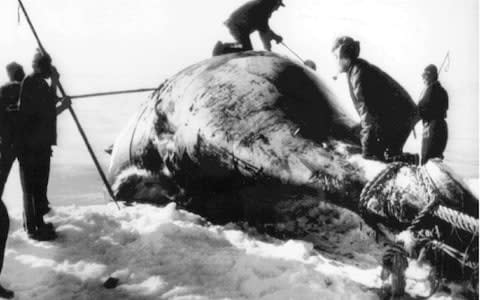'Lifespan clock' reveals bowhead whales live to 268...the oldest mammals on Earth

Surviving for at least 200 years, the bowhead whale is the longest living mammal on Earth but zoologists have struggled to discover its true life expectancy.
Now, a groundbreaking genetic study has built the first ‘lifespan clock’ which can predict how long an animal will live, simply based on its DNA.
After analysing the genetic code of 252 vertebrates, Australian scientists found 42 genes which predict length of life, and were able to tell that the average bowhead will live for 268 years, some 57 years longer than the oldest known whale.
Long-lived animals are notoriously difficult to track from birth to death, because researchers do not live long enough to follow them throughout their lives.
For some species, like the Greenland shark which may live more than 500 years, scientists are forced to use carbon dating, but the inaccuracy of the process means that estimates can be out by more than 100 years.
Some bowhead whales have been discovered with harpoons dating from the 1880s, proving they can survive for huge periods but their true lifespan has remained a mystery.

Writing in the journal Scientific Reports, Dr Benjamin Mayne, a molecular biologist at the Commonwealth Scientific and Industrial Research Organisation (CSIRO) in Canberra, said: “Bowhead whales are thought to be the longest living mammal, with one individual estimated as 211 years old.
“It is rarely possible to follow long-lived species from birth to death as they would normally out live a generation of researchers.
“Using our lifespan estimator and the bowhead whale genome, we estimated the maximum longevity of the bowhead whale to be 268 years. This lifespan estimate is 57 years more than the oldest aged individual to date.”
The team also applied their lifespan clock to extinct species and discovered that the life expectancy of Neanderthals was 37.8. Likewise the Woolly Mammoth would have lived to 60, while the passenger pigeon which died out in 1914 had a lifespan of 28 years.
And they were able to reassess the true lifespan to the Pinta Island Tortoise, of which the last male, known as Lonesome George, died aged 102 on the Galapagos islands in 2012.

“The lifespan clock also creates a new opportunity to study the biology of extinct species, where ancient DNA methods can provide genome assemblies,” added Dr Mayne.
“It estimated the maximum lifespan of the Pinta Island tortoise to be 120 years old. This lifespan estimation is 10–20 years higher than most estimates of Lonesome George’s age at death.”
The 'lifespan clock' screens 42 selected genes for short pieces of DNA whose density is correlated with lifespan, to predict how long members of a given vertebrate species may live.
However, the researchers found it was impossible to create a clock for invertebrate species from their DNA, and they have not yet tested it on the Greenland shark, so its true age continues to remain elusive.
The research was published in the journal Scientific Reports.

 Yahoo News
Yahoo News 
